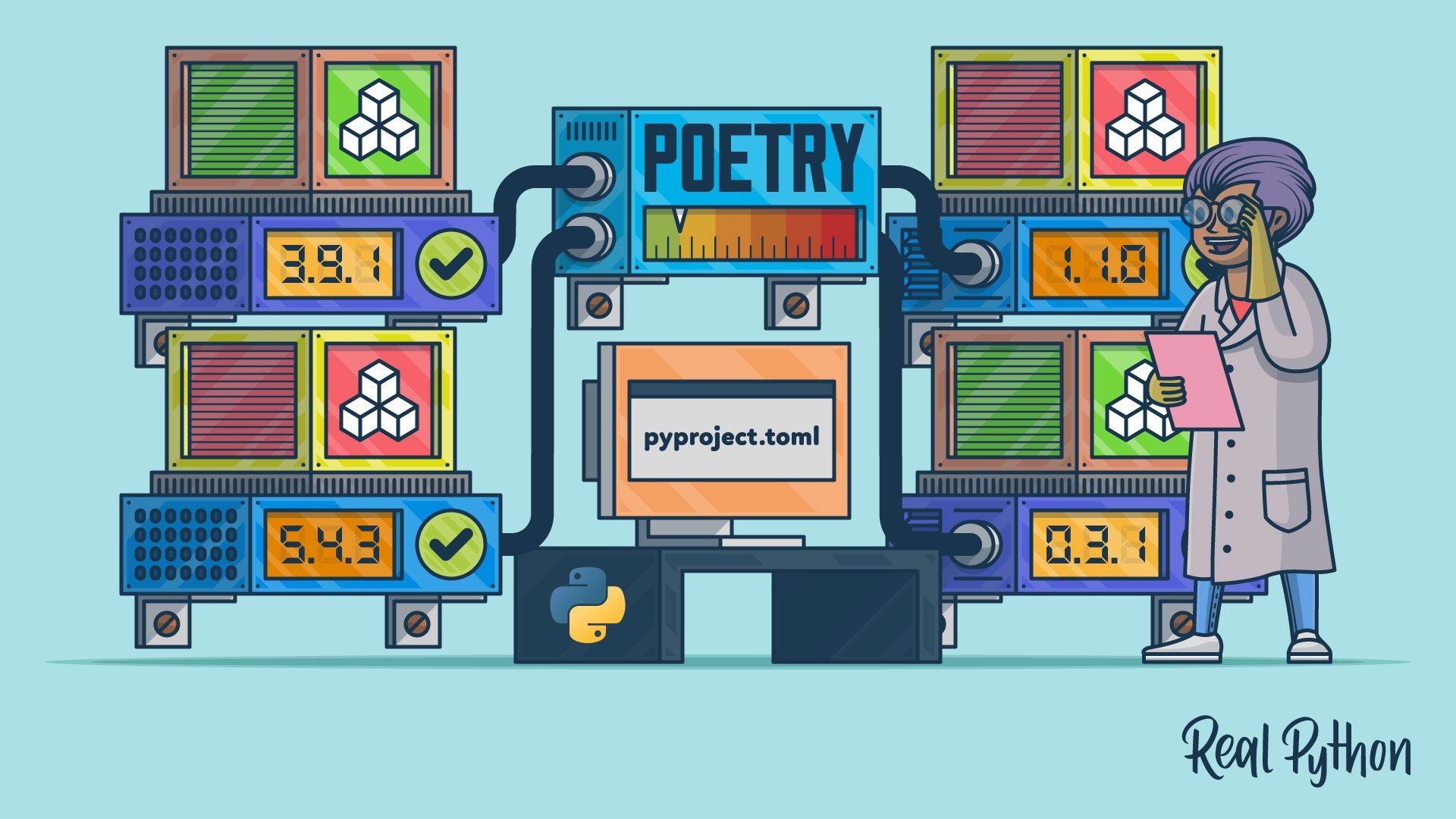When your Python project relies on external packages, you need to make sure you’re using the right version of each package. After an update, a package might not work as it did before the update. A dependency manager like Python Poetry helps you specify, install, and resolve external packages in your projects. This way, you can be sure that you always work with the right dependency version on every machine.
In this tutorial, you’ll learn how to:
- Start a new Poetry project
- Add Poetry to an existing project
- Use the
pyproject.tomlfile - Pin dependencies
- Install dependencies with
poetry.lock - Execute basic Poetry CLI commands
Using Poetry will help you start new projects, maintain existing ones, and master dependency management.
You’ll be prepared to work with pyproject.toml files, which will be the standard for defining build requirements in Python projects.
To complete this tutorial and get the most out of it, you should have a basic understanding of virtual environments, modules and packages, and pip.
While this tutorial focuses on dependency management, Poetry can also help you with building and packaging projects. If you want to share your work, then you can even publish your Poetry project to the Python Packaging Index (PyPI).
Free Bonus: Click here to get access to a free 5-day class that shows you how to avoid common dependency management issues with tools like Pip, PyPI, Virtualenv, and requirements files.
Take Care of Prerequisites
Before diving into the nitty-gritty of Python Poetry, you’ll take care of some prerequisites. First, you’ll read a short overview of terminology you’ll encounter in this tutorial. Next, you’ll install Poetry itself.
Relevant Terminology
If you’ve ever used an import statement in one of your Python scripts, then you’ve worked with modules.
Some of these modules might have been Python files you wrote on your own.
Others could have been built-in modules, like datetime.
However, sometimes what Python provides isn’t enough.
That’s when you might turn to external, packaged modules.
When your Python code relies on external modules, you can say that these packages are dependencies of your project.
You can find packages that aren’t part of the Python standard library in PyPI. Before seeing how this works, you need to install Poetry on your system.
Python Poetry Installation
To use Poetry in your command line, you should install it system-wide.
If you just want to try it out, then you can install it into a virtual environment using pip.
But you should try this method with caution because Poetry will install its own dependencies, which can conflict with other packages you’re using in your project.
The recommended way to install Poetry is by using the official install-poetry script.
You can either download and run this Python file manually or select your operating system below to use the appropriate command:
In the output, you should see a message that the installation is complete.
You can run poetry --version in your terminal to see if poetry works.
This command will display your current Poetry version.
If you want to update Poetry, then you can run poetry self update.
Get Started With Python Poetry
With Poetry installed, it’s time to see how Poetry works.
In this section, you’ll learn how to start a fresh Poetry project and how to add Poetry to an existing project.
You’ll also see the project structure and inspect the pyproject.toml file.
Create a New Poetry Project
You can create a new Poetry project by using the new command and a project name as an argument.
In this tutorial, the project is called rp-poetry.
Create the project, and then move into the newly created directory:
$ poetry new rp-poetry
$ cd rp-poetry
By running poetry new rp-poetry, you create a new folder named rp-poetry/.
When you look inside the folder, you’ll see a structure:
rp-poetry/
│
├── rp_poetry/
│ └── __init__.py
│
├── tests/
│ ├── __init__.py
│ └── test_rp_poetry.py
│
├── README.rst
└── pyproject.toml
Poetry automatically normalizes package names for you.
It transformed the dash (-) in your project name into an underscore (_) in the folder name of rp_poetry/.
Otherwise, the name wouldn’t be allowed in Python, so you couldn’t import it as a module.
To have more control over creating the package name, you can use the --name option to name it differently than the project folder:
$ poetry new rp-poetry --name realpoetry
If you prefer to store your source code in an additional src/ parent folder, then Poetry lets you stick to that convention by using the --src flag:
$ poetry new --src rp-poetry
$ cd rp-poetry
By adding the --src flag, you’ve created a folder named src/, which contains your rp_poetry/ directory:
rp-poetry/
│
├── src/
│ │
│ └── rp_poetry/
│ └── __init__.py
│
├── tests/
│ ├── __init__.py
│ └── test_rp_poetry.py
│
├── README.rst
└── pyproject.toml
When creating a new Poetry project, you’ll receive a basic folder structure right away.
Inspect the Project Structure
The rp_poetry/ subfolder itself isn’t very spectacular yet.
Inside this directory, you’ll find an __init__.py file with your package’s version:
# rp_poetry/__init__.py
__version__ = "0.1.0"
When you hop over to the tests/ folder and open test_rp_poetry.py, you’ll notice that rp_poetry is already importable:
# tests/test_rp_poetry.py
from rp_poetry import __version__
def test_version():
assert __version__ == "0.1.0"
Poetry has also added a first test to the project.
The test_version() function checks whether the __version__ variable of rp_poetry/__init__.py contains the expected version.
However, the __init__.py file isn’t the only place where you define the version of your package.
The other location is the pyproject.toml file.
Use the pyproject.toml File
One of the most important files for working with Poetry is the pyproject.toml file.
This file isn’t an invention of Poetry.
It’s a configuration file standard that was defined in PEP 518:
This PEP specifies how Python software packages should specify what build dependencies they have in order to execute their chosen build system. As part of this specification, a new configuration file is introduced for software packages to use to specify their build dependencies (with the expectation that the same configuration file will be used for future configuration details). (Source)
The authors considered a few file formats for the “new configuration file” mentioned in the quote above.
In the end, they decided on the TOML format, which stands for Tom’s Obvious Minimal Language.
In their opinion, TOML is flexible enough, with better readability and less complexity than the other options, which are YAML, JSON, CFG, or INI.
To see how TOML looks, open the pyproject.toml file:
1# pyproject.toml
2
3[tool.poetry]
4name = "rp-poetry"
5version = "0.1.0"
6description = ""
7authors = ["Philipp <philipp@realpython.com>"]
8
9[tool.poetry.dependencies]
10python = "^3.9"
11
12[tool.poetry.dev-dependencies]
13pytest = "^5.2"
14
15[build-system]
16requires = ["poetry-core>=1.0.0"]
17build-backend = "poetry.core.masonry.api"
You can see four sections in the pyproject.toml file.
These sections are called tables.
They contain instructions that tools like Poetry recognize and use for dependency management or build routines.
If a table name is tool-specific, it must be prefixed with tool.
By using such a subtable, you can add instructions for different tools in your project.
In this case, there is only tool.poetry.
But you might see examples like [tool.pytest.ini_options] for pytest in other projects.
In the [tool.poetry] subtable on line 3 above, you can store general information about your Poetry project.
Your available keys are defined by Poetry.
While some keys are optional, there are four that you must specify:
name: the name of your packageversion: the version of your package, ideally following semantic versioningdescription: a short description of your packageauthors: a list of authors, in the formatname <email>
The subtables [tool.poetry.dependencies] on line 9 and [tool.poetry.dev-dependencies] on line 12 are essential for your dependency management.
You’ll learn more about these subtables in the next section when you add dependencies to your Poetry project.
For now, the important thing is to recognize that there is differentiation between package dependencies and development dependencies.
The last table of the pyproject.toml file is [build-system] on line 15.
This table defines data that Poetry and other build tools can work with, but as it’s not tool-specific, it doesn’t have a prefix.
Poetry created the pyproject.toml file with two keys in place:
requires: a list of dependencies that are required to build the package, making this key mandatorybuild-backend: the Python object used to perform the build process
If you want to learn a bit more about this section of the pyproject.toml file, then you can find out more by reading about source trees in PEP 517.
When you start a new project with Poetry, this is the pyproject.toml file you start with.
Over time, you’ll add configuration details about your package and the tools you’re using.
As your Python project grows, your pyproject.toml file will grow with it.
This is particularly true for the subtables [tool.poetry.dependencies] and [tool.poetry.dev-dependencies].
In the next section, you’ll find out how to expand these subtables.
Work With Python Poetry
Once you’ve set up a Poetry project, the real work can begin. You can start coding once Poetry is in place. Along the way, you’ll find out how Poetry provides you with a virtual environment and takes care of your dependencies.
Use Poetry’s Virtual Environment
When you start a new Python project, it’s good practice to create a virtual environment. Otherwise, you may confuse different dependencies from different projects. Working with virtual environments is one of Poetry’s core features, and it’ll never interfere with your global Python installation.
However, Poetry doesn’t create a virtual environment right away when you start a project.
You can confirm that Poetry hasn’t created a virtual environment by having Poetry list all virtual environments connected to the current project.
If you haven’t already, cd into rp-poetry/ and then run a command:
$ poetry env list
For now, there shouldn’t be any output.
Poetry will create a virtual environment along the way when you run certain commands. If you want to have better control over the creation of a virtual environment, then you might decide to tell Poetry explicitly which Python version you want to use for it and go from there:
$ poetry env use python3
With this command, you’re using the same Python version that you used to install Poetry.
Using python3 works when you have the Python executable in your PATH.
Note: Alternatively, you can pass an absolute path to a Python executable.
It should match the Python version constraint you can find in your pyproject.toml file.
If it doesn’t, then you may run into trouble because you’re working with a different Python version than the version your project requires.
Code that works in your environment could be buggy on another machine.
Even worse, external packages often rely on specific Python versions. Consequently, a user installing your package might get an error because your dependency versions are incompatible with their Python version.
When you run env use, you’ll see a message:
Creating virtualenv rp-poetry-AWdWY-py3.9 in ~/Library/Caches/pypoetry/virtualenvs
Using virtualenv: ~/Library/Caches/pypoetry/virtualenvs/rp-poetry-AWdWY-py3.9
As you can see, Poetry constructed a unique name for your project’s environment. The name contains the project name and the Python version. The seemingly random string in the middle is a hash of your parent directory. With this unique string in the middle, Poetry can handle multiple projects with the same name and the same Python version on your system. That’s important because, by default, Poetry creates all your virtual environments in the same folder.
Without any other configuration, Poetry creates the virtual environments in the virtualenvs/ folder of Poetry’s cache directory:
| Operating System | Path |
|---|---|
| macOS | ~/Library/Caches/pypoetry |
| Windows | C:\Users\<username>\AppData\Local\pypoetry\Cache |
| Linux | ~/.cache/pypoetry |
If you want to change the default cache directory, then you can edit Poetry’s configuration.
This can be useful when you’re already using virtualenvwrapper or another third-party tool for managing your virtual environments.
To see the current configuration, including the configured cache-dir, you can run a command:
$ poetry config --list
Usually, you don’t have to change this path. If you want to learn more about interacting with Poetry’s virtual environments, then the Poetry documentation contains a chapter about managing environments.
As long as you’re inside your project folder, Poetry will use the virtual environment associated with it.
If you’re ever in doubt, you can check whether the virtual environment is activated by running the env list command again:
$ poetry env list
This will display something like rp-poetry-AWdWY-py3.9 (Activated).
With an activated virtual environment, you’re ready to start managing some dependencies and see Poetry shine.
Declare Your Dependencies
A key element of Poetry is its handling of your dependencies.
Before you get the ball rolling, take a look at the two dependency tables in the pyproject.toml file:
# rp_poetry/pyproject.toml (Excerpt)
[tool.poetry.dependencies]
python = "^3.9"
[tool.poetry.dev-dependencies]
pytest = "^5.2"
There are currently two dependencies declared for your project.
One is Python itself.
The other is pytest, a widely used testing framework.
As you’ve seen before, your project contains a tests/ folder and a test_rp_poetry.py file.
With pytest as a dependency, Poetry can run your tests immediately after installation.
Note: At the time of writing this tutorial, running pytest with Poetry using Python 3.10 doesn’t work. Poetry installs a pytest version that is incompatible with Python 3.10.
The Poetry developers are aware of this issue, and it will be fixed with the release of Poetry 1.2.
Make sure that you’re inside the rp-poetry/ project folder and run a command:
$ poetry install
With the install command, Poetry checks your pyproject.toml file for dependencies then resolves and installs them.
The resolving part is especially important when you have many dependencies that require different third-party packages with different versions of their own.
Before installing any packages, Poetry figures out which version of a package fulfills the version constraints that other packages set as their requirements.
Besides pytest and its requirements, Poetry also installs the project itself.
This way, you can import rp_poetry into your tests right away:
# tests/test_rp_poetry.py
from rp_poetry import __version__
def test_version():
assert __version__ == "0.1.0"
With your project’s package installed, you can import rp_poetry into your tests and check for the __version__ string.
With pytest installed, you can use the poetry run command to execute the tests:
1$ poetry run pytest
2========================= test session starts ==========================
3platform darwin -- Python 3.9.1, pytest-5.4.3, py-1.10.0, pluggy-0.13.1
4rootdir: /Users/philipp/Real Python/rp-poetry
5collected 1 item
6
7tests/test_rp_poetry.py . [100%]
8
9========================== 1 passed in 0.01s ===========================
Your current test is running successfully, so you can confidently continue coding.
However, if you look closely at line 3, something looks a bit odd.
It says pytest-5.4.3, not 5.2 like stated in the pyproject.toml file.
Good catch!
To recap, the pytest dependency in your pyproject.toml file looks like this:
# rp_poetry/pyproject.toml (Excerpt)
[tool.poetry.dev-dependencies]
pytest = "^5.2"
The caret (^) in front of 5.2 has a specific meaning, and it’s one of the versioning constraints that Poetry provides.
It means that Poetry can install any version that matches the leftmost non-zero digit of the version string.
This means that using 5.4.3 is allowed.
Version 6.0 wouldn’t be allowed.
A symbol like the caret will become important when Poetry tries to resolve the dependency versions. If there are only two requirements, this isn’t too hard. The more dependencies you declare, the more complicated it gets. Let’s see how Poetry handles this by installing new packages into your project.
Install a Package With Poetry
You may have used pip before to install packages that aren’t part of the Python standard library.
If you run pip install with the package name as an argument, pip looks for packages on the Python Package Index.
You can use Poetry the same way.
If you want to add an external package like requests to your project, then you can run a command:
$ poetry add requests
By running poetry add requests, you’re adding the latest version of the requests library to your project.
You can use version constraints like requests<=2.1 or requests==2.24 if you want to be more specific.
When you don’t add any constraints, Poetry will always try to install the latest version of the package.
Sometimes there are packages that you only want to use in your development environment.
With pytest, you spotted one of them already.
Another common library includes a code formatter like Black, a documentation generator like Sphinx, and a static analysis tool like Pylint, Flake8, mypy, or coverage.py.
To explicitly tell Poetry that a package is a development dependency, you run poetry add with the --dev option.
You can also use a shorthand -D option, which is the same as --dev:
$ poetry add black -D
You added requests as a project dependency and black as a development dependency.
Poetry has done a few things for you in the background.
For one thing, it added your declared dependencies to the pyproject.toml file:
# rp_poetry/pyproject.toml (Excerpt)
[tool.poetry.dependencies]
python = "^3.9"
requests = "^2.26.0"
[tool.poetry.dev-dependencies]
pytest = "^5.2"
black = "^21.9b0"
Poetry added the requests package as a project dependency to the tool.poetry.dependencies table, while it added black as a development dependency to tool.poetry.dev-dependencies.
Differentiating between project dependencies and development dependencies prevents installing requirements that a user doesn’t need to run the program.
The development dependencies are only relevant for other developers of your package who want to run tests with pytest and make sure the code is properly formatted with black.
When users install your package, they only install requests with it.
Note: You can go even further and declare optional dependencies. This can be handy when you want to give users the option to install a specific database adapter that isn’t required but enhances your package. You can learn more about optional dependencies in the Poetry documentation.
Besides the changes to the pyproject.toml file, Poetry also created a new file named poetry.lock.
In this file, Poetry keeps track of all packages and the exact versions you’re using in the project.
Handle poetry.lock
When you run the poetry add command, Poetry automatically updates pyproject.toml and pins the resolved versions in the poetry.lock file.
However, you don’t have to let Poetry do all the work.
You can manually add dependencies to the pyproject.toml file and lock them afterward.
Pin Dependencies in poetry.lock
If you want to build a web scraper with Python, then you may want to use Beautiful Soup to parse your data.
Add it to the tool.poetry.dependencies table in the pyproject.toml file:
# rp_poetry/pyproject.toml (Excerpt)
[tool.poetry.dependencies]
python = "^3.9"
requests = "^2.26.0"
beautifulsoup4 = "4.10.0"
By adding beautifulsoup4 = "4.10.0", you’re telling Poetry that it should install exactly this version.
When you add a requirement to the pyproject.toml file, it’s not installed yet.
As long as there’s no poetry.lock file present in your project, you can run poetry install after manually adding dependencies, because Poetry looks for a poetry.lock file first.
If it doesn’t find one, Poetry resolves the dependencies listed in the pyproject.toml file.
As soon as a poetry.lock file is present, Poetry will rely on this file to install dependencies.
Running only poetry install would trigger a warning that both files are out of sync and would produce an error because Poetry wouldn’t know of any beautifulsoup4 versions in the project yet.
To pin manually added dependencies from your pyproject.toml file to poetry.lock, you must first run the poetry lock command:
$ poetry lock
Updating dependencies
Resolving dependencies... (1.5s)
Writing lock file
By running poetry lock, Poetry processes all dependencies in your pyproject.toml file and locks them into the poetry.lock file.
And Poetry doesn’t stop there.
When you run poetry lock, Poetry also recursively traverses and locks all dependencies of your direct dependencies.
Note: The poetry lock command also updates your existing dependencies if newer versions that fit your version constraints are available .
If you don’t want to update any dependencies that are already in the poetry.lock file, then you have to add the --no-update option to the poetry lock command:
$ poetry lock --no-update
Resolving dependencies... (0.1s)
In this case, Poetry only resolves the new dependencies but leaves any existing dependency versions inside the poetry.lock file untouched.
Now that you’ve pinned all dependencies, it’s time to install them so that you can use them in your project.
Install Dependencies From poetry.lock
If you followed the steps from the previous section, then you’ve already installed pytest and black by using the poetry add command.
You’ve also locked beautifulsoup4, but you haven’t installed Beautiful Soup yet.
To verify that beautifulsoup4 isn’t installed yet, open the Python interpreter with the poetry run command:
$ poetry run python3
Executing poetry run python3 will open an interactive REPL session in Poetry’s environment.
First, try to import requests.
This should work flawlessly.
Then try importing bs4, which is the module name for Beautiful Soup.
This should throw an error because Beautiful Soup isn’t installed yet:
>>> import requests
>>> import bs4
Traceback (most recent call last):
File "<stdin>", line 1, in <module>
ModuleNotFoundError: No module named 'bs4'
As expected, you can import requests without any trouble, and the module bs4 can’t be found.
Exit the interactive Python interpreter by typing exit() and hitting Enter.
After locking dependencies with the poetry lock command, you have to run the poetry install command so that you can actually use them in your project:
$ poetry install
Installing dependencies from lock file
Package operations: 2 installs, 0 updates, 0 removals
• Installing soupsieve (2.2.1)
• Installing beautifulsoup4 (4.10.0)
Installing the current project: rp-poetry (0.1.0)
By running poetry install, Poetry reads the poetry.lock file and installs all dependencies that are declared in it.
Now, bs4 is ready for you to use in your project.
To test this, enter poetry run python3 and import bs4 into the Python interpreter:
>>> import bs4
>>> bs4.__version__
'4.10.0'
Perfect!
No errors this time, and you have the exact version you declared.
This means that Beautiful Soup is pinned correctly in your poetry.lock file, is installed in your project, and is ready to use.
To list available packages in your project and inspect their details, you can use the show command.
When you run it with the --help flag, you’ll see how to use it:
$ poetry show --help
To inspect a package, you can use show with the package name as an argument, or you can use the --tree option to list all dependencies as a tree.
This will help you see the nested requirements of your project.
Update Dependencies
For updating your dependencies, Poetry provides different options depending on two scenarios:
- Update a dependency inside your version constraints.
- Update a dependency outside your version constraints.
You can find your version constraints in your pyproject.toml file.
When a new version of a dependency still fulfills your version constraints, you can use the update command:
$ poetry update
The update command will update all your packages and their dependencies within their version constraints.
Afterward, Poetry will update your poetry.lock file.
If you want to update one or more specific packages, then you can list them as arguments:
$ poetry update requests beautifulsoup4
With this command, Poetry will search for a new version of requests and a new version of beautifulsoup4 that fulfill the version constraints listed in your pyproject.toml file.
Then it’ll resolve all dependencies of your project and pin the versions into your poetry.lock file.
Your pyproject.toml file will stay the same because the listed constraints remain valid.
If you want to update a dependency with a version that’s higher than the defined version in the pyproject.toml file, you need to adjust the pyproject.toml file beforehand.
Another option is to run the add command with a version constraint or the latest tag:
$ poetry add pytest@latest --dev
When you run the add command with the latest tag, it looks for the latest version of the package and updates your pyproject.toml file.
Including the latest tag or a version constraint is critical in using the add command.
Without it, you’d get a message that the package is already present in your project.
Also, don’t forget to add the --dev flag for development dependencies.
Otherwise, you’d add the package to your regular dependencies.
After adding a new version, you must run the install command you learned about in the section above.
Only then are your updates locked into the poetry.lock file.
If you’re not sure which version-based changes an update would introduce to your dependencies, you can use the --dry-run flag.
This flag works for both the update and the add commands.
It displays the operations in your terminal without executing any of them.
This way, you can spot version changes safely and decide which update scenario works best for you.
Distinguish Between pyproject.toml and poetry.lock
While the version requirement in the pyproject.toml file can be loose, Poetry locks the versions you’re actually using in the poetry.lock file.
That’s why you should commit this file if you’re using Git.
By providing a poetry.lock file in a Git repository, you ensure that all developers will use identical versions of required packages.
When you come across a repository that contains a poetry.lock file, it’s a good idea to use Poetry for it.
With poetry.lock, you can make sure that you use exactly the versions the other developers are using.
And if the other developers aren’t using Poetry, you can add it to an existing project that wasn’t set up with Poetry.
Add Poetry to an Existing Project
Chances are, you have projects that you didn’t start with the poetry new command.
Or maybe you inherited a project that wasn’t created with Poetry, but now you want to use Poetry for your dependency management.
In these types of situations, you can add Poetry to existing Python projects.
Add pyproject.toml to a Scripts Folder
If your project only contains some Python files, then you can still add Poetry as a foundation for future builds.
In this example, there’s only one file, hello.py:
# rp-hello/hello.py
print("Hello World!")
The only thing this script does is to output the string "Hello World!".
But maybe this is just the beginning of a grand project, so you decide to add Poetry to your project.
Instead of using the poetry new command from before, you’ll use the poetry init command:
$ poetry init
This command will guide you through creating your pyproject.toml config.
Package name [rp-hello]: rp-hello
Version [0.1.0]:
Description []: My Hello World Example
Author [Philipp <philipp@realpython.com>, n to skip]:
License []:
Compatible Python versions [^3.9]:
Would you like to define your main dependencies interactively? (yes/no) [yes] no
Would you like to define your development dependencies interactively? (yes/no) [yes] no
Generated file
The poetry init command will start an interactive session to create a pyproject.toml file.
Poetry gives you recommendations for most of the configurations you need to set up, and you can press Enter to use them.
When you don’t declare any dependencies, the pyproject.toml file that Poetry creates looks something like this:
# rp-hello/pyproject.toml
[tool.poetry]
name = "rp-hello"
version = "0.1.0"
description = "My Hello World Example"
authors = ["Philipp <philipp@realpython.com>"]
[tool.poetry.dependencies]
python = "^3.9"
[tool.poetry.dev-dependencies]
[build-system]
requires = ["poetry-core>=1.0.0"]
build-backend = "poetry.core.masonry.api"
The content looks similar to the examples that you went through in the previous sections.
Now you can use all the commands that a Poetry project offers.
With a pyproject.toml file present, you can now run scripts:
$ poetry run python3 hello.py
Creating virtualenv rp-simple-UCsI2-py3.9 in ~/Library/Caches/pypoetry/virtualenvs
Hello World!
Because Poetry didn’t find any virtual environments to use, it created a new one before executing your script.
After doing this, it displays your Hello World! message without any errors.
That means you now have a working Poetry project.
Use an Existing requirements.txt File
Sometimes you have projects that already have a requirements.txt file.
Take a look at the requirements.txt file of this Python web scraper:
$ cat requirements.txt
beautifulsoup4==4.9.3
certifi==2020.12.5
chardet==4.0.0
idna==2.10
requests==2.25.1
soupsieve==2.2.1
urllib3==1.26.4
With the cat utility, you can read a file and write the content to the standard output.
In this case, it shows the dependencies of the web scraper project.
Once you’ve created the Poetry project with poetry init, you can combine the cat utility with the poetry add command:
$ poetry add `cat requirements.txt`
Creating virtualenv rp-require-0ubvZ-py3.9 in ~/Library/Caches/pypoetry/virtualenvs
Updating dependencies
Resolving dependencies... (6.2s)
Writing lock file
Package operations: 7 installs, 0 updates, 0 removals
• Installing certifi (2020.12.5)
• Installing chardet (4.0.0)
• Installing idna (2.10)
• Installing soupsieve (2.2.1)
• Installing urllib3 (1.26.4)
• Installing beautifulsoup4 (4.9.3)
• Installing requests (2.25.1)
When a requirements file is straightforward like this, using poetry add and cat can save you some manual work.
Sometimes requirements.txt files are a bit more complicated, however.
In those cases, you can either execute a test run and see how it turns out or add requirements by hand to the [tool.poetry.dependencies] table in the pyproject.toml file.
To see if the structure of your pyproject.toml is valid, you can run poetry check afterward.
Create requirements.txt From poetry.lock
In some situations, you must have a requirements.txt file.
For example, maybe you want to host your Django project on Heroku.
For cases like this, Poetry provides the export command.
If you have a Poetry project, you can create a requirements.txt file from your poetry.lock file:
$ poetry export --output requirements.txt
Using the poetry export command in this way creates a requirements.txt file that includes hashes and environment markers.
This means that you can be sure to work with very strict requirements that resemble the content of your poetry.lock file.
If you also want to include your development dependencies, you can add --dev to the command.
To see all available options, you can check poetry export --help.
Command Reference
This tutorial has introduced you to Poetry’s dependency management. Along the way, you’ve used some of Poetry’s command-line interface (CLI) commands:
| Poetry Command | Explanation |
|---|---|
$ poetry --version |
Show the version of your Poetry installation. |
$ poetry new |
Create a new Poetry project. |
$ poetry init |
Add Poetry to an existing project. |
$ poetry run |
Execute the given command with Poetry. |
$ poetry add |
Add a package to pyproject.toml and install it. |
$ poetry update |
Update your project’s dependencies. |
$ poetry install |
Install the dependencies. |
$ poetry show |
List installed packages. |
$ poetry lock |
Pin the latest version of your dependencies into poetry.lock. |
$ poetry lock --no-update |
Refresh the poetry.lock file without updating any dependency version. |
$ poetry check |
Validate pyproject.toml. |
$ poetry config --list |
Show the Poetry configuration. |
$ poetry env list |
List the virtual environments of your project. |
$ poetry export |
Export poetry.lock to other formats. |
You can check out the Poetry CLI documentation to learn more about the commands above and the other commands Poetry offers.
You can also run poetry --help to see information right in your terminal!
Conclusion
In this tutorial, you explored how to create a new Python Poetry project and how to add Poetry to an existing one.
A key part of Poetry is the pyproject.toml file.
In combination with poetry.lock, you can ensure that you install the exact version of each package that your project requires.
When you track the poetry.lock file in your Git repository, you also make sure that all other developers in the project install the same dependency versions on their machines.
In this tutorial, you learned how to:
- Start a new Poetry project
- Add Poetry to an existing project
- Use the
pyproject.tomlfile - Pin dependencies
- Install dependencies with
poetry.lock - Execute basic Poetry CLI commands
This tutorial focused on the basics of Poetry’s dependency management, but Poetry can also help you build and upload your package. If you want to get a taste of this capability, then you can read about how to use Poetry when publishing an open source Python package to PyPI).









